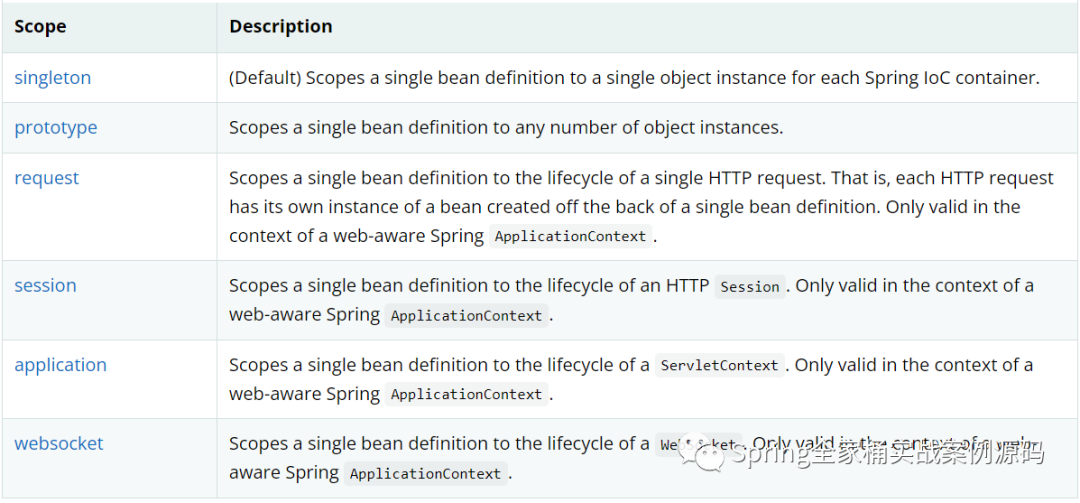环境:Spring5.3.23
一. 简介
Spring Scope Bean是Spring用于管理Bean的作用域的一种机制。它定义了容器中Bean的生命周期和实例化策略,即如何创建Bean实例。
在Spring中,Bean的作用域包括单例(singleton)、原型(prototype)、请求(request)、会话(session)等。每个作用域都有其特定的使用场景和行为:
- 单例(singleton):这是Spring默认的作用域,表示在整个Spring容器中,只有一个Bean实例存在。无论你从哪个地方获取这个Bean,都将返回同一个实例。
- 原型(prototype):每次从容器中请求Bean时,都会创建一个新的Bean实例。
- 请求(request):在一个HTTP请求的范围内,Bean是单例的。这种作用域适用于与单个请求关联的Bean。
- 会话(session):在一个HTTP会话的范围内,Bean是单例的。这种作用域适用于与单个用户会话关联的Bean。
此外,Spring还提供了其他一些作用域应用(Application)、WebSocket,以满足不同场景的需求。
通过合理地选择Bean的作用域,可以优化应用的性能和资源利用率。例如,对于需要频繁创建和销毁实例的Bean,使用原型作用域会更高效;而对于需要在多个请求或会话之间共享状态的Bean,则可以选择单例或会话作用域。附官方图:
 图片
图片
接下来将分别介绍每一种作用域bean。
二. 作用域应用
基础类
static class Person {
@Override
public String toString() {
return super.toString() + " - " + this.hashCode() + "" ;
}
}2.1 单例(singleton)
默认使用@Bean,@Service,@Controller注解标注的注解都是单例的。也可以同@Scope注解指定作用域为单例
@Bean
// 不指定@Scope默认就是单例
@Scope(value = "singleton")
public Person person() {
return new Person() ;
}测试
try (AnnotationConfigApplicationContext context = new AnnotationConfigApplicationContext()) {
context.registerBean(Config.class) ;
context.refresh() ;
System.out.println(context.getBean(Person.class)) ;
System.out.println(context.getBean(Person.class)) ;
}控制台输出
com.pack.main.scope.ScopeMain5$Person@5e0e82ae - 1578009262
com.pack.main.scope.ScopeMain5$Person@5e0e82ae - 1578009262每次获取的都是同一个实例。
原理
public abstract class AbstractBeanFactory {
protected <T> T doGetBean(...) {
// ...
// 判断是否是单例
if (mbd.isSingleton()) {
// 先从单例池中查找是否已经存在,不存在则调用createBean创建,
// 然后存入单例池中
sharedInstance = getSingleton(beanName, () -> {
try {
return createBean(beanName, mbd, args);
}
});
}
// ...
}
}2.2 原型(prototype)
每次从容器中请求Bean时,都会创建一个新的Bean实例。
@Bean
@Scope(value = "prototype")
public Person person() {
return new Person() ;
}控制台输出
com.pack.main.scope.ScopeMain5$Person@fa4c865 - 262457445
com.pack.main.scope.ScopeMain5$Person@3bd82cf5 - 1004023029每次获取都是不同的对象。
原理
public abstract class AbstractBeanFactory {
protected <T> T doGetBean(...) {
// ...
// 判断是否是单例
if (mbd.isSingleton()) {
// ...
}
// 判断是否是原型
else if (mbd.isPrototype()) {
Object prototypeInstance = null;
try {
// 不存在什么缓存池,直接创建bean实例返回
prototypeInstance = createBean(beanName, mbd, args);
}
}
// ...
}
}这里考虑一个问题,如何在单例bean中正确的注入原型bean?
2.3 请求(request)
接下来都是与web环境相关了,所以这里演示的示例会以SpringBoot3.0.5环境演示。
基础类
@Component
@Scope(value = "request")
public class Person {
}测试类
@RestController
@RequestMapping("/scopes")
public class ScopeController {
@Resource
private Person person ;
@Resource
private PersonService ps ;
@GetMapping("/request")
public Person request() {
System.out.println("ScopeController: " + person) ;
ps.query() ;
return person ;
}
}Service
@Service
public class PersonService {
@Resource
private Person person ;
public void query() {
System.out.println("PersonService: " + person) ;
}
}如果上面这样配置,启动服务将会报错:
Caused by: java.lang.IllegalStateException: No thread-bound request found: Are you referring to request attributes outside of an actual web request, or processing a request outside of the originally receiving thread? If you are actually operating within a web request and still receive this message, your code is probably running outside of DispatcherServlet: In this case, use RequestContextListener or RequestContextFilter to expose the current request.
at org.springframework.web.context.request.RequestContextHolder.currentRequestAttributes(RequestContextHolder.java:131) ~[spring-web-6.0.7.jar:6.0.7]该错误的原因就是你在一个单例bean中注入一个request作用域的bean,而request作用域bean的生命周期是在一个web请求开始创建的,所以这里你当然是没法注入的。
解决办法:
- @Scope设置代理模式
@Component
@Scope(value = "request", proxyMode = ScopedProxyMode.TARGET_CLASS)
public class Person {}测试结果
ScopeController: com.pack.scopes.Person@106a9684 - 275420804
PersonService: com.pack.scopes.Person@106a9684 - 275420804
ScopeController: com.pack.scopes.Person@64396678 - 1681483384
PersonService: com.pack.scopes.Person@64396678 - 1681483384每次请求接口都获取的不是同一个实例。并且在一个完整的请求中获取的Person都是同一个。
- 使用@RequestScope
该注解原理与上面其实一致的
@Scope(WebApplicationContext.SCOPE_REQUEST)
public @interface RequestScope {
@AliasFor(annotation = Scope.class)
// 设置好了使用代理
ScopedProxyMode proxyMode() default ScopedProxyMode.TARGET_CLASS;
}2.4 会话(session)
@Component
@Scope(value = "session", proxyMode = ScopedProxyMode.TARGET_CLASS)
// 与request一样,必须设置代理模式或者使用下面这个注解
// @SessionScope
public class Person {}测试
ScopeController: com.pack.scopes.Person@2b56038d - 727057293
PersonService: com.pack.scopes.Person@2b56038d - 727057293
ScopeController: com.pack.scopes.Person@2b56038d - 727057293
PersonService: com.pack.scopes.Person@2b56038d - 727057293多次访问都是同一个session;你再换个浏览器访问
ScopeController: com.pack.scopes.Person@1aa201fd - 446824957
PersonService: com.pack.scopes.Person@1aa201fd - 446824957
ScopeController: com.pack.scopes.Person@1aa201fd - 446824957
PersonService: com.pack.scopes.Person@1aa201fd - 446824957此时对象就是一个新的了,不同的浏览器访问当然不是同一个session了。
2.5 应用(application)
@Scope(value = "application", proxyMode = ScopedProxyMode.TARGET_CLASS)
// @ApplicationScope
// 都是web环境,所以情况都一样
public class Person {}测试
360浏览器
ScopeController: com.pack.scopes.Person@6371b4b6 - 1668396214
PersonService: com.pack.scopes.Person@6371b4b6 - 1668396214Chrome浏览器
ScopeController: com.pack.scopes.Person@6371b4b6 - 1668396214
PersonService: com.pack.scopes.Person@6371b4b6 - 1668396214他们是同一个对象,application作用域生命周期与整个应用一样,只有你关闭了服务器,在启动后才会是再重新创建的bean对象。
3. web作用域原理
3.1 注册作用域
public abstract class AbstractApplicationContext {
public void refresh() {
postProcessBeanFactory(beanFactory);
}
}
public class AnnotationConfigServletWebServerApplicationContext {
protected void postProcessBeanFactory(ConfigurableListableBeanFactory beanFactory) {
super.postProcessBeanFactory(beanFactory);
}
}
public class ServletWebServerApplicationContext {
protected void postProcessBeanFactory(ConfigurableListableBeanFactory beanFactory) {
// ...
registerWebApplicationScopes();
}
private void registerWebApplicationScopes() {
WebApplicationContextUtils.registerWebApplicationScopes(getBeanFactory());
}
}
public abstract class WebApplicationContextUtils {
public static void registerWebApplicationScopes(ConfigurableListableBeanFactory beanFactory) {
registerWebApplicationScopes(beanFactory, null);
}
public static void registerWebApplicationScopes(ConfigurableListableBeanFactory beanFactory,
@Nullable ServletContext sc) {
// 注册作用域
beanFactory.registerScope(WebApplicationContext.SCOPE_REQUEST, new RequestScope());
beanFactory.registerScope(WebApplicationContext.SCOPE_SESSION, new SessionScope());
if (sc != null) {
ServletContextScope appScope = new ServletContextScope(sc);
beanFactory.registerScope(WebApplicationContext.SCOPE_APPLICATION, appScope);
}
}
}这里每一种web作用域都有一个对应的Scope实现RequestScope,SessionScope,ServletContextScope。
3.2 查找web作用域bean
public abstract class AbstractBeanFactory {
protected <T> T doGetBean(...) {
// ...
// 判断是否是单例
if (mbd.isSingleton()) {
// ...
}
// 判断是否是原型
else if (mbd.isPrototype()) {
Object prototypeInstance = null;
try {
// 不存在什么缓存池,直接创建bean实例返回
prototypeInstance = createBean(beanName, mbd, args);
}
}
// 其它作用域bean,如上面的web作用域
else {
String scopeName = mbd.getScope();
Scope scope = this.scopes.get(scopeName);
if (scope == null) {
throw new IllegalStateException("No Scope registered for scope name '" + scopeName + "'");
}
try {
// 通过具体Scope的实现类获取bean对象
Object scopedInstance = scope.get(beanName, () -> {
beforePrototypeCreation(beanName);
try {
// 首次都还是会创建
return createBean(beanName, mbd, args);
}
});
}
}
}
// ...
}
}总结:Spring Scope Bean是Spring框架中用于管理Bean的作用域的机制,它定义了Bean的生命周期和实例化策略。通过合理地选择Bean的作用域,可以优化应用的性能和资源利用率。


































